There`s no decision more important to a musician than choosing what instrument they should play.
If you are like me, you feel a natural pull toward the stringed instruments. The only issue is that there are two of them, and choosing between the bass and the guitar is a tough choice.
Therefore, I have written this guide to help you choose by showcasing every difference between the two instruments.
I`ve primarily been a bass player for 15 years now. I`ve actually played the guitar even longer, and while I`ve played it less than the bass, I have lots of experience playing both instruments.
Thus, I`m going to start by giving you a side-by-side comparison of the bass vs the guitar. Then, I`ll go through every key aspect of the two instruments that will make a difference to you as a musician.
With that, I aim to answer every question you have about deciding between the two, as well as some you may not have considered yet.
Key differences between the bass and the guitar
In the table below, I`ve listed the key differences between the bass and the guitar side by side.
This will give you a general overview of how the two instruments differ before we dive into the more detailed stuff.
| Guitar | Bass | |
| Cost of an entry-level instrument | $100-$250 | $100-$250 |
| Cost of intermediate to advanced instrument | Acoustic: 400$+ Electric: 600$+ | $1000+ |
| Dimensions | Acoustic: 102cm x 38cm x 10cm (40″ x 15″ x 4″) Electric: 102cm x 30cm x 5.5cm (40″ x 12″ x 2.2″) | 118cm x 30cm x 6cm (46″ x 12″ x 2.5″) |
| Most common Scale Length | 24.75″-25.5″ | 34″ |
| Weight | Electric: 6-9lb (2.7kg-4.1kg) Acoustic: 2.5lb-5lb (1.1kg – 2.3kg) | 8-10lb / 3.6kg-4.5kg |
| Amount of strings | 6 strings* (7-string guitars are common in some genres of music) | 4 strings* (5-string basses are also common. 6-string basses exist, but are less common) |
| Standard Tuning | E-A-D-G-B-E | E-A-D-G |
| Lowest note | E2 | E1 |
| Frequency range | 82.4Hz -1109Hz (21 Frets) | 41.2Hz – 311Hz (20 Frets) |
| Melodic range | E2-C#6 (21 Frets) | E1 – D#4 (20 Frets) |
| Role In a band | Playing chord progressions, leads, melodies, and solos. Providing harmony. | Playing deep grooves to provide harmony and rhythm. Connecting the drums and the harmonic instruments. |
| Mainly plays | Chords | Single Notes |
| Popularity | High | Low |
| Played with | Mainly a pick, or alternatively with your fingers | Fingers, A Pick, or with your thumb |
| Origin | Preceded by the Oud and the Lute. | Preceded by the double bass. |
| As a solo instrument | Excellent, and commonly used as such | Decent, but rarely used as such |
| As a composing tool | Great | Mediocre |
Is it harder to learn bass or guitar?
In general, the bass is a more beginner-friendly instrument than the guitar and is easier to play at a basic level. While learning to play either instrument well is hard, intermediate guitarists often find the instrument progressively easier to play, whereas bass players find it progressively harder.
In other words, the bass starts off easy and becomes harder. The guitar starts off hard and becomes easier. To get a better feel for why this is, let`s take a look at what learning each instrument looks like:
Learning the guitar
When learning to play simple guitar parts, you can`t get much done before you learn to strum and switch between chords. Because it is much harder to switch the position of 2 to 4 fingers, rather than 1, guitarists need to put in more initial practice than bass players.
What makes this even harder is that you are not always strumming all 6 strings of the guitar. For example, when moving from a D chord to an Em chord, you have to go from strumming 4 strings to 6 strings.
Thus, it will also take some time before you are able to prevent unwanted strings from ringing out.
As you become better at playing the guitar, switching between chords will become second nature. You will also become more skilled at playing riffs and leads.
As a result, you can build upon the skills you have already developed and thus see a natural path towards getting better at the instrument. Thus, the begging stages of learning the guitar are general what feels the hardest.
This does not mean that the guitar is easy to master. Becoming proficient at the instrument takes years of practice. However, the initial stages of learning to play the guitar require you to learn a lot of new skills at once and is thus the stage that I and many others have found the hardest.
Learning the bass
In my article on The difficulty of playing bass, I go into detail about why it’s a beginner-friendly instrument. A big reason for this is that there are a ton of simple basslines that beginners can learn from day one.
Playing sustained whole notes or straightforward 8th note grooves adequately is something most everyone can learn within weeks. Writing simple basslines for original music is also relatively undemanding once you develop a basic understanding of chords.
However, becoming an intermediate bass player can only be achieved with time.
This is in part because playing the bass well requires real-life experience from playing with other musicians. It also requires you to have enough control of the instrument to adjust your plucking to add the right feeling and groove to a song.
In other words, playing the bass is easy, but playing the bass well is hard.
Furthermore, the bass plays an important role in bands. For a band to sound cohesive, you need to work together with the drummer and guitarist at the same time. You also need to be able to adjust your articulation and tone to fit different songs.
Becoming aware of how impactful these skills are and developing them is both time-consuming and difficult. Thus, it is common to find the bass more challenging to play at an intermediate stage than as a beginner.
For an instrument that is harder for beginners, but easier at an intermediate stage, play the guitar
For an instrument that is easier for beginners, but harder at an intermediate stage, play the bass

Sound
While the bass and guitar look similar, they differ greatly in how they sound.
In order to get a feel for this, here is what a bass sounds like in isolation:
Bass Line:
This is a simple bassline that changes key from E to A. If a guitarist were to play a similar part, they would usually play chords instead of a single note at a time. Here is what that would sound like:
Guitar chords:
When played together, the bass and guitar work together to create a wide harmonic layer. The bass fills in the low-end and makes the song sound wider and provides a groove to it. The guitar plays at a higher frequency, fills the higher parts of the mix, and adds harmony.
This works incredibly well sonically and is the key reason most bands have both a guitarist and a bass player. When playing together, they sound like this:
Played Together:
To understand why the instruments fill so different roles, let`s listen to what it would sound like if they tried to do the job of the other.
Due to the low frequency of the bass guitar, bass chords tend to sound boomy and unpleasant. If a bassist plays deep chords together with a band, this can thus quickly make the whole band sound incoherent.
Note: There are ways to make a bass sound like a guitar. Some bassists have made this work extremely well, though it is an unconventional way to play the instrument.
Here is what the above guitar chords would sound like on the bass. It does not sound pleasant, and while I have normalized the volume, I recommend turning down your sound for this one:
Bass playing guitar chords:
When playing bass on the guitar, we run into the opposite problem.
This doesn`t sound as bad as guitar chords on the bass, and can often be a great way to introduce songs. However, when played as a rhythm part, bass grooves tend to sound thin and powerless on the guitar. Therefore, guitarists tend to play chords or leads instead.
Here is what the above bass part sounds like on the guitar:
Bassline being played on the guitar:
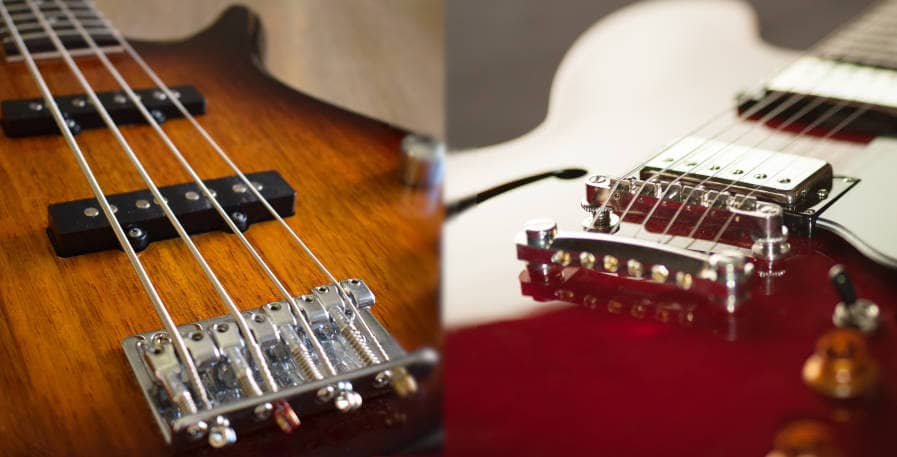
Size & Weight
Normal-sized guitars are about 38″ to 40″ (97-102 cm) long, whereas basses are ~46″ (117cm). Thus, while their sizes will differ between different instruments, basses are approximately 1.22 times longer than guitars.
This also impacts the weight of the instruments. The bass guitar is slightly heavier than the electric guitar (~1-3lb depending on the model). Compared to the acoustic guitar, basses are everything from twice up to four times as heavy.
As a result, the bass is more demanding to play while standing up for longer periods of time than the guitar. The size of the instrument can also make the bass harder to play for people with small hands, or for young musicians below the age of 12-13.
This is not a deal breaker, and there are bassists below the age of 10 who are able to play the long-scale bass better than I can after 15 years. However, for these reasons some bassists prefer to start out on a short-scale bass.
If you want to play a small and light instrument, play the guitar (or a short-scale bass)
If you`d prefer a large and heavy instrument, play the bass
Popularity & Demand
When researching how in-demand bassists are, most people thought that guitarists outnumber bassists between 4:1 and 6:1. Several people thought the ratio was as wide as 10:1. While these are educated guesses, it does give us a general idea of the difference in popularity between the two instruments.
Another way to compare their popularity is by looking at what people are searching for on google. On average, “Playing Guitar” is searched for 5.88 times more often than playing “Playing Bass” in the US.
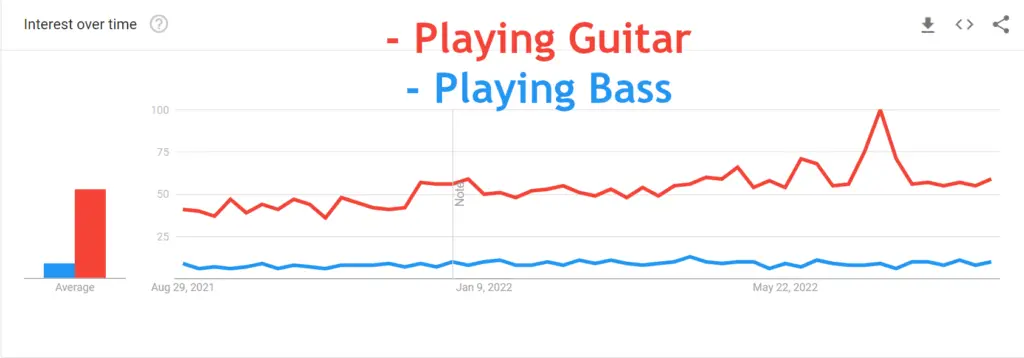
Furthermore, according to a survey of more than 2000 people, the guitar is a more popular instrument than vocals and drums. The bass, on the other hand, is less popular than both.
As a result, it is significantly easier for bassists to find session work and find bands to play in than it is for guitar players.
On the flip side, there are upsides to the popularity of the guitar as well. There are more resources to learn from, and a lot more notable players to draw inspiration from. It`s also easier to find people who share your interest. There is also a wider selection of guitar gear than bass gear.
For an instrument that has ample resources but low demand, play the guitar
For an instrument with less available resources but high demand, play the bass
Tuning
Both the 4-string bass and 6-string guitar use E standard as their main tuning.
This means that the deepest string on both instruments is an E. It also means that the strings on both instruments are tuned at a perfect fourth interval.
Thus, the strings on a bass are tuned E-A-D-G, and the strings on a guitar are tuned E-A-D-G-B-E. The difference between the two is that the guitar is tuned in E standard an octave higher, and the bass has less range than the guitar due to having fewer strings.
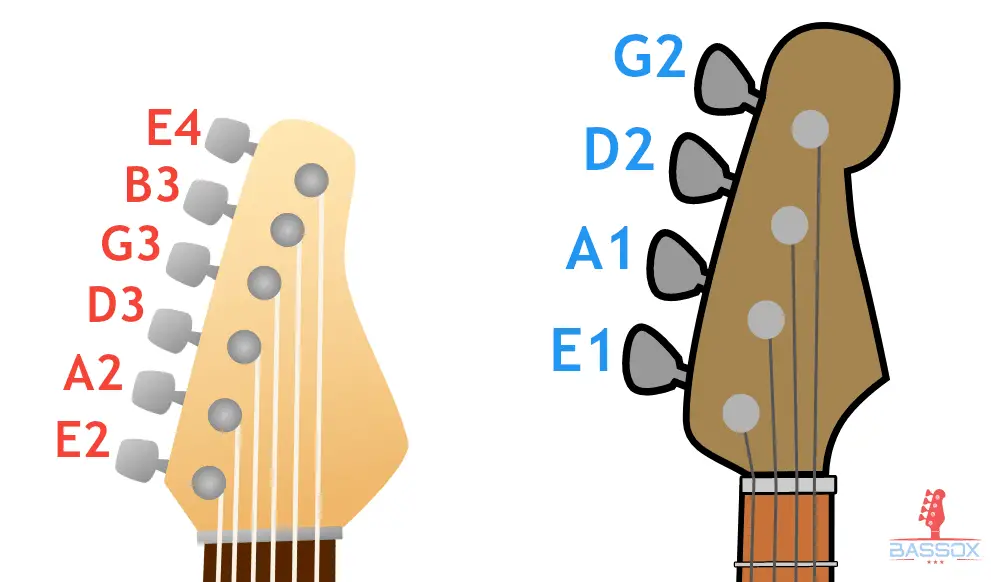
Note: If you are familiar with music theory, you might have noticed that the B string on the guitar breaks the perfect fourth pattern. Instead, it is tuned at a major third interval from the G string. This is to make playing chords easier and to tune the highest string to E.
The fact that both instruments share the same standard tuning carries many benefits.
This means basslines will sound harmonic on the guitar, and guitar parts will sound harmonic when played on the bass. This also makes it easier to transition between the two instruments.
Another upside is that playing in the same tuning makes it easier for guitarists and bass players to work together in a band. For example, you can share ideas and riffs without transposing them, which saves a lot of time.
Furthermore, 5-string basses and 7-string guitars both use B standard as their main tuning. Thus, the upsides mentioned above will also apply when playing 5 and 7 strings.
This also holds true when playing in an alternate tuning such as Drop D. Therefore, it is common for bassists and guitarists who play in the same band to play in the same tuning.
Playing Chords
The bass is generally played 1 note at a time, while multiple notes are played at a time on the guitar.
However, despite rarely playing multiple notes at a time, bass players do in fact play chords. The difference is that they play the notes of the chord one at a time to add melodic variation and groove.
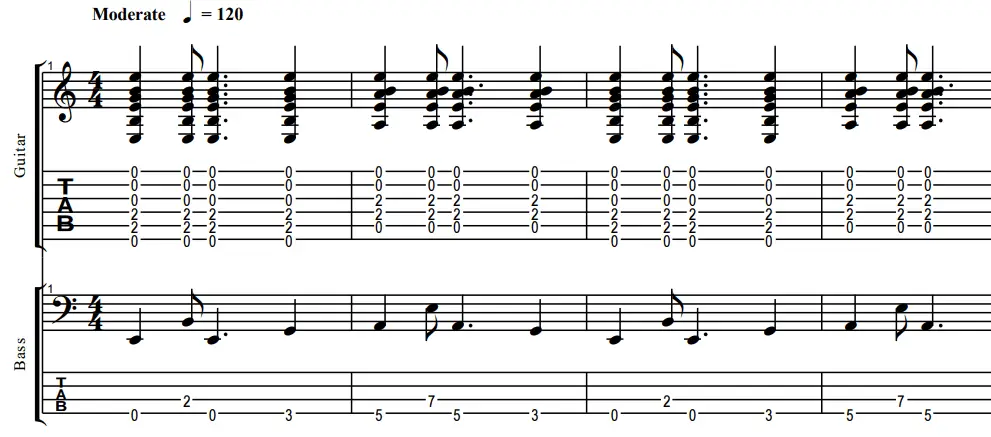
Guitarists often do the same thing but tend to let the strings ring out instead of muting them. Playing chords in this manner results in a melody, while still providing the full depth of the chord.
Bassists very rarely let the strings ring out in this manner. This is because low bass chords sound muddy when they get to ring out, as demonstrated earlier.
Instead, the bass picks notes from the chord to create a bassline that`s groovy while still sounding harmonic with the guitar. It plays the notes one at a time without letting them ring out to avoid sounding muffled. This makes it harder to pick out the chord than when listening to the guitar.
However, as the guitar is already playing the entire chord, the bass does not need the strings to ring out.
Instead, the bass provides the root note of the chord at the start of each bar. This strengthens the feeling of the chord when the two instruments are playing together. After establishing the root note, the bass can switch to playing other notes of the chord, which is what makes for groovy basslines:
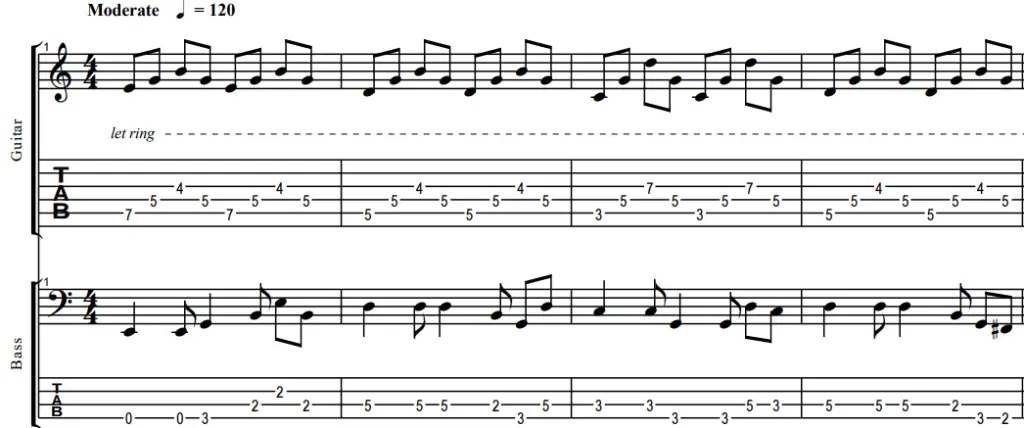
If you want to play chord progressions and multiple notes at the same time, play the guitar.
If you want to construct grooves out of the individual notes of a chord, play the bass.

Personality
When choosing between the bass and guitar, it is helpful to consider what type of person you are.
The bass is mainly a supporting instrument. As a result, good basslines often make the other members of the band look good, rather than the bassist.
The guitar is often the center of attention when there isn`t a vocal part. It often introduces songs alone, and guitar solos are common in most forms of music.
Because of this, if you enjoy lifting others up rather than making yourself look good, it will be harder to do so on the guitar than on the bass.
Likewise, if you prefer having the spotlight on you, the bass might not fit you as well. You will have fewer opportunities to be in the center of attention, and as a result, find the instrument less fulfilling.
There are of course exceptions to this. Bassists like Geddy Lee of Rush and Chris Squire of Yes are just some of the bassists that have written amazing bass solos and taken on more of a lead role. There are also guitarists that take on less of a lead role, which is particularly common in indie rock.
However, at its core, the bass is a supporting instrument even when playing more complex lines. Thus, while your personality shouldn`t solely dictate which instrument you choose, there are personality traits that fit bassists, and traits that fit guitarists.
If you enjoy making others look good and prefer staying in the back, play the bass
If you enjoy making yourself look good and being the center of attention, play the guitar
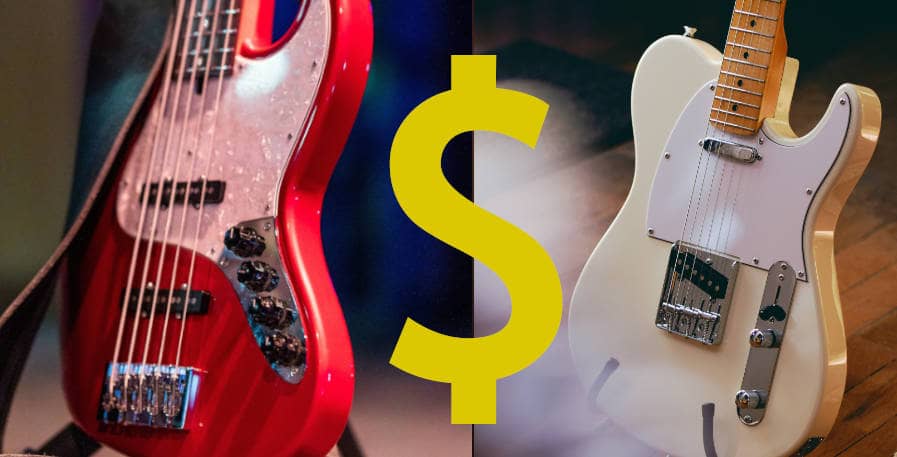
Cost
Guitars and basses can both be found from $100 and up, with no upper ceiling to how much they can cost.
Basses and guitars in the 100$ range tend to be second-hand or mass-produced. I would generally not recommend these instruments to a beginner, but they are an option if you are on a budget. Decent entry-level guitars and basses generally sell in the $200 to $250 range.
For intermediate and professional instruments, you will find both guitars and basses in every price range. They start from ~$400 and up, and can in rare cases go as high as 6-digits in cost.
With that said, at large basses tend to be slightly more expensive than guitars. You can find both guitars and basses at $500 or $1000, but for instruments of similar quality, basses tend to cost slightly more.
This is mainly due to the guitar being a more popular instrument. For this reason, guitars are produced in larger quantities than basses, which in turn decreases production costs.
Then there is the simple fact that basses are bigger than guitars. Thus, they require more raw materials to make which also increases the manufacturing cost.
For the same two reasons, bass strings are also more expensive than guitar strings. Commonly, a set of bass strings will cost ~$25, and a set of guitar strings will cost ~$10.
With all of that said, these differences in cost come out to a negligible difference. While playing the bass is slightly more expensive on average, the difference in cost is so small that I would not put significant weight on it when choosing between the two instruments.
Cost is a small and negligible factor when choosing between the bass and the guitar.
If slight differences in initial cost and upkeep make a difference or you are on a very tight budget, play the guitar
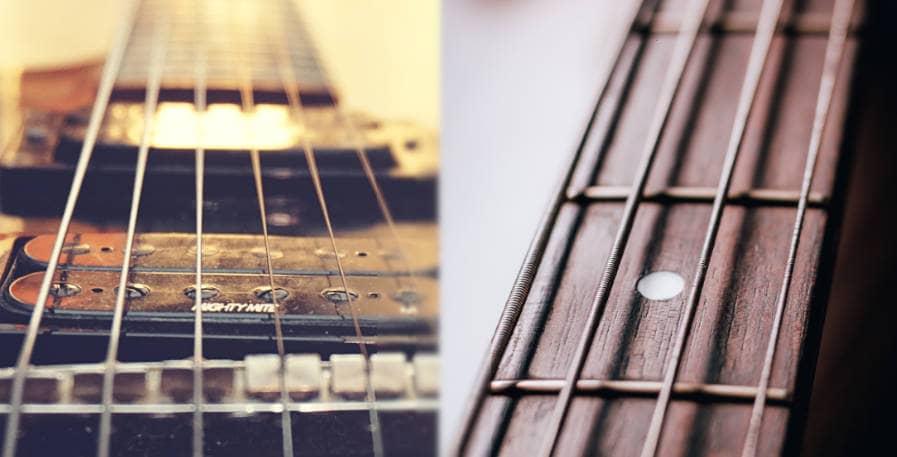
Strings
Most basses have 4-strings whereas the guitar has 6, and there are good reasons why this is the case.
Additional high strings would enable the bass to play high melodies and chords easier. However, as the instrument is rarely used for this purpose, further strings would for most bass players be redundant. For playing low-end grooves, 4 strings tend to be more than sufficient.
Guitars, on the other hand, are used for playing chords and melodies. Having multiple high strings is thus important for voicing chords in different ways. This also enables guitarists to fluidly move between chords and to find finger placements that naturally incorporate every note of the chord.
Furthermore, the strings on a bass are tuned an octave lower than on the guitar. For this reason, bass strings are significantly thicker than guitar strings:
- Common string thicknesses for a 6-sting guitar: 46-36-26-17-13-10
- Common string thicknesses for a 7-string guitar: 59-46-36-26-17-13-10
- Common string thicknesses for a 4-string bass: 105-85-70-50
- Common string thicknesses for a 5-string bass: 130-100-80-65-45
Thus, fretting and plucking bass strings leads to more friction than when playing the guitar. While both guitarists and bassists tend to do so, bassists are therefore more prone to developing blisters.
Thicker strings also require more stamina to play. Thus, in the beginning, it’s more demanding to play the bass for extended periods of time, than it is to play the guitar.
If you prefer thin strings and playing multiple notes at a time, play the guitar
If you prefer thick strings and playing single note grooves, play the bass

Singing While Playing
In general, it is a lot harder to sing while playing the bass than it is to sing while playing the guitar.
The reason it`s hard to sing while playing bass is that basslines are often syncopated to the main rhythm. This means that it is playing on the back-beat, and articulates notes at different times than the main pulse of the song.
While this makes bass lines sound funky, it also makes it difficult to sing while playing them. This is because it can feel like you are playing a different song than you are singing and that the two parts don`t align naturally.
On the surface, the guitar can seem harder due to having to play multiple notes at a time while singing. However, what makes singing while playing difficult has less to do with what notes you are playing, and more to do with the rhythm.
The rhythm of guitar parts tends to align intuitively with vocal parts. Thus, while challenging in its own right, it is generally easier to play the guitar than the bass while singing.
Many songs are also written by singing guitar players. These songs tend to be more natural to sing while playing, as they were written with this purpose in mind.
While some bands have lead vocalists that play the bass, it is far less common. As a result, basslines are rarely written to be played while singing and are thus generally more challenging.
It`s worth mentioning that there are exceptions to this. In particular, there are many basslines that consist of sustained whole notes or straight 8th notes. This makes for songs that are easy to sing while playing the bass.
However, not all songs will be this easy. Thus, while singing while playing the bass can be beginner-friendly if you choose the right songs, it is a skill that will skyrocket in difficulty as you move on to more demanding ones.
For an instrument that is less challenging to play while singing, play the guitar
For an instrument that is more challenging to play while singing, play the bass
Conclusion
Choosing between the bass and the guitar is not easy. Both have their pros and cons, and most of them come down to personal preference.
To summarize some of the key differences, here is an infographic. Feel free to pin it, save it, or use it however you feel like.
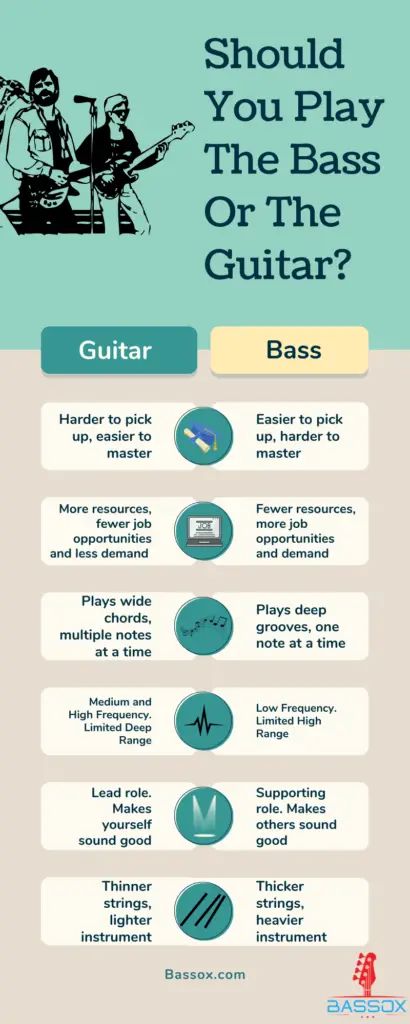
Hopefully, this article shed some light on why people choose the bass over the guitar, and vice versa.
Lastly, remember that picking either instrument does not commit you to playing it for life. I thought I was meant to be a keyboardist. It was not until I had tried the keyboard, guitar, and drums, that I found out the bass was right for me.
The only way I could find out was through trying, and the same holds true for you.
Also, picking either now and switching later is a lot better than picking neither. Plus, playing bass will make you a better guitar player, and playing guitar will make you a better bassist, so don`t sweat it too much.
With that, I hope you can make an informed decision about which instrument to choose. And regardless of which instrument you choose, thank you for reading, and I wish you the best of luck on your musical journey.

